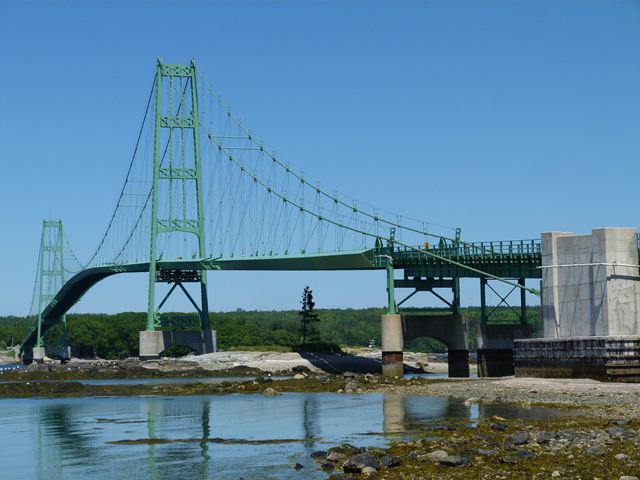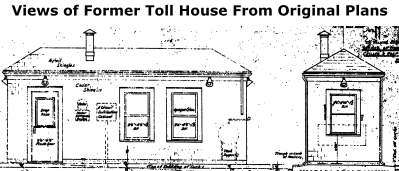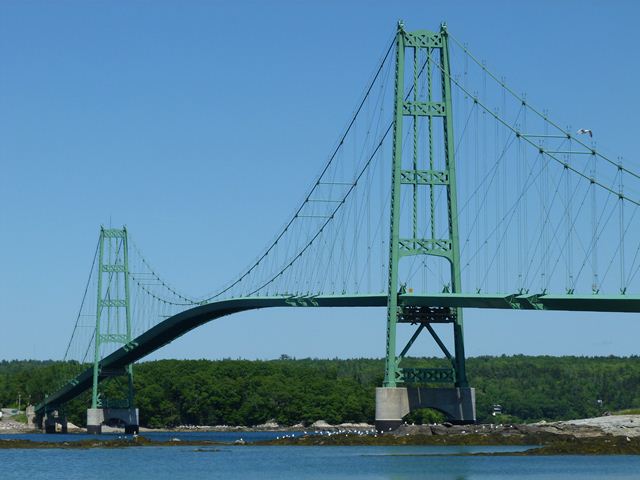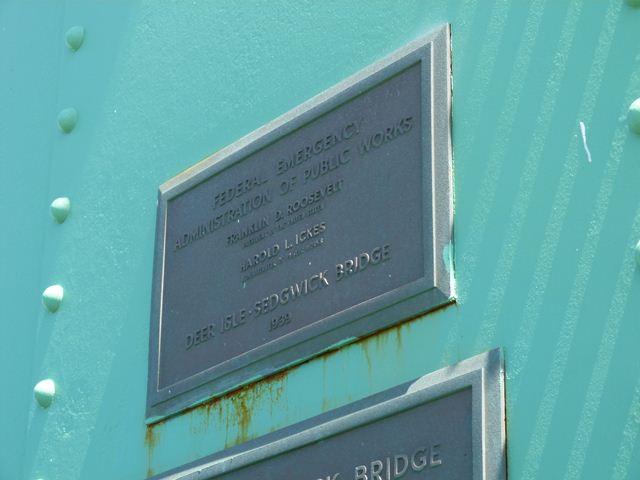We Recommend:
Bach Steel - Experts at historic truss bridge restoration.
Deer Isle Bridge
Deer Isle - Sedgwick Bridge

Primary Photographer(s): Nathan Holth
Bridge Documented: June 17, 2012
ME-15 (Little Deer Isle Road, Byards Point Road) Over Eggemoggin Reach
Rural: Hancock County, Maine: United States
Metal Through Plate Girder Stiffening Wire Cable Suspension, Fixed and Approach Spans: Metal Deck Girder, Fixed
1939 By Builder/Contractor: Phoenix Bridge Company of Phoenixville, Pennsylvania and Engineer/Design: Robinson and Steinman of New York, New York
2010
1,080.0 Feet (329.2 Meters)
2,505.0 Feet (763.5 Meters)
23.6 Feet (7.19 Meters)
3 Main Span(s) and 7 Approach Span(s)
3257

View Information About HSR Ratings
Bridge Documentation
View Archived National Bridge Inventory Report - Has Additional Details and Evaluation
View Historic American Engineering Record (HAER) Documentation For This Bridge
View Historical Article About This Bridge
HAER Data Pages, PDF
A Bridge Significant For Its Imperfections
This bridge is an extremely significant historic bridge as a large-span suspension bridge designed by David B. Steinman, one of the greatest suspension bridge engineers in United States history. The Deer Isle Bridge is however perhaps one of the most unusual Steinman bridges, for the simple reason that its original design fell short of perfect. Most Steinman bridges are examples of nothing short of the finest work in bridge engineering, with a quality of design and construction no longer found in bridge construction today. Overall, the Deer Isle Bridge was designed with this level of quality, however, as originally constructed it did have one serious flaw. The bridge's stiffening girder was designed far too shallow for a bridge of this length. The function of a stiffening girder or truss in a suspension bridge is to keep the deck of the bridge rigid enough so that the wind and other loads cannot cause the bridge to develop wave-like oscillations that can damage the bridge. The Deer Isle Bridge was built during a period where many engineers were trying to design increasingly shallow stiffening systems for suspension bridges, following the development of new theory in how suspension bridges worked. The shallow girders would not only be more economical to construct, but would give suspension bridges a more lightweight and streamlined appearance that matched the aesthetic preferences for this period. Evidence of other engineers tinkering with shallow stiffening systems during this period in history is evident in the Bronx-Whitestone Bridge. Perhaps the best example of this experimentation is the failure of the Tacoma Narrows Bridge, which was completed in 1940 with extremely shallow stiffening girders and collapsed a few months later when a windy day created such severe oscillations in the deck that it tore the bridge apart, sending the entire deck into the water below. The collapse of the Tacoma Narrows Bridge was a wake-up call for the Bronx Whitestone Bridge as well as the Deer Isle Bridge. Soon after the Tacoma Narrows Bridge collapse, action was taken to stiffen these bridges. The Bronx Whitestone Bridge had full-size stiffening trusses added to it, as well as some cable stays to further stiffen the bridge. The Deer Isle Bridge on the other hand was able to retain its original stiffening girders. Instead, Steinman returned and designed a system of cable stays and floor stays that were added to the bridge to stiffen the bridge. Evidence that these cable stays were not part of the original bridge are painfully obvious when standing under the main tower, where cable stays tie into the stiffening girders at a large gusset plate. This gusset plate somewhat obstructs the easy viewing of the original bridge plaques, which were mounted on the tower. Had this cable stay system been a part of the original bridge design, these plaques would not have been placed where they were. More recently, in 1993 the bridge received additional protection from wind. A special system of fairings that direct wind over and below the girders were attached to the outside of the girders. The fairings were designed by Steinman's consulting engineering firm, which by then was known as Steinman Boynton Gronquist and Birdsall, although Steinman himself had died many years earlier.
The Deer Isle Bridge is a bridge that is extremely significant, providing invaluable insight into the history of David Steinman and how his engineering philosophy evolved. Prior to the Deer Isle Bridge, Steinman was content to design traditional suspension bridges with ample stiffening trusses, like the Waldo Hancock Bridge. His experimentation with shallow stiffening systems resulted in the Deer Isle Bridge. Then, following the realization that he had pushed a little too far beyond the limits of physics with the Deer Isle Bridge, Steinman did not give up on the bridge, but instead his firm quickly returned and designed a cable and floor stay system to secure the bridge. All the problems that developed with shallow stiffening systems, from his own Deer Isle Bridge, to the collapse of the Tacoma Narrows Bridge (not designed by Steinman) appear to have had a profound effect on Steinman's philosophy. Steinman then went on to design what was then the world's longest suspension bridge and his crowning achievement, the Mackinac Bridge. The Mackinac Bridge demonstrates that Steinman learned from his mistake. The Mackinac Bridge, with extremely deep stiffening trusses and open grating integrated into the deck to permit air flow allowed the Mackinac Bridge to set records for stability, with the bridge designed to withstand winds in excess of 300 miles per hour. Put simply, the stability of the Mackinac Bridge makes a sharp contrast to the instability of the Deer Isle Bridge, prior to stabilization efforts.
In summary, the Deer Isle Bridge is historically significant because it helps tell the story of important bridge engineer David Steinman. Someone studying the Mackinac Bridge who wonders why the bridge has such an excessive safety factor built into its design can look to the Deer Isle Bridge and gain some insight into why. Additionally, the bridge is an example of how creative engineering of the period turned a bridge that was poorly designed into a safe and functional bridge without need for costly demolition and replacement. Finally, the bridge is noteworthy as a large-scale bridge built with assistance from Depression-era relief funds. Typical of such bridges, the bridge's main plaques are designed to a federal government template (rather than a state design) and one of the plaques lists President Franklin D. Roosevelt.
The preservation of the Deer Isle Bridge should take the highest of priorities in transportation planning for Maine. Its shortcomings having been corrected, the bridge today is safe, and if maintained can be expected to provide reliable, cost-effective service for many decades to come.
|
Main Plaque DEER ISLE - SEDGWICK BRIDGEERECTED FOR THE STATE OF MAINE LEWIS O BARROWS GOVERNOR BY A JOINT BOARD CONSISTING OF THE STATE HIGHWAY COMMISSIONERS
THE HANCOCK COUNTY COMMISSIONERS
THE BRIDGE DISTRICT TRUSTEES
ROBINSON AND STEINMAN, ENGINEERS D. G. LETOURNEAU, RESIDENT ENGINEER CONTRACTORS MERRITT-CHAPMAN AND SCOTT CORPORATION THE PHOENIX BRIDGE COMPANY 1939 |
|
Federal Emergency Administration of Public Works Plaque FEDERAL EMERGENCYADMINISTRATION OF PUBLIC WORKS FRANKLIN D. ROOSEVELT PRESIDENT OF THE UNITED STATES HAROLD L. ICKES ADMINISTRATOR OF PUBLIC WORKS DEER ISLE - SEDGWICK BRIDGE 1939 |
Dedication Plaque THIS BRIDGE DEDICATEDTO THE HONOR AND MEMORY OF FRANK MCGUIRE WHOSE UNTIRING AND UNSELFISH DEVOTION TRANSFORMED A VISION INTO A UTILITY THAT WILL SERVE FOREVER |
Information and Findings From Maine's Historic Bridge InventoryDiscussion of Bridge "The main spans of the 2505'-long, 1939 Deer Isle-Sedgwick Bridge are a cable suspended, 1080'-long main span between the towers and 484'-long side spans. The anchorages consist of eye-bars embedded in concrete. The approach spans grade of 6.5% and a vertical curve of 400' at the center of the span were design decisions to reduce construction costs by minimizing the length of the approach spans. As early as 1939, aerodynamic instability was noted, and dealing with this limitation remains a constant challenge. Guys radiating out from the towers were installed, and ties were placed between the cables and the stiffening girders at mid span. In 1994, U-shaped wind fairings were placed on the exterior faces of the stiffening girders in an effort to dampen the effects of the wind. The bridge was determined eligible by MHPC in 1992, and it is a historically and technologically significant example of the suspension bridge type. Noted, mid-20th century consulting engineer David B. Steinman designed it. This span is noteworthy for its shallow stiffening girders. The 6.5'-deep stiffening girders reflect the 1930s trend toward thinner girders for aesthetic and economic reasons. The bridge also incorporates Steinman's earlier innovations like prestressed cable and Vierendeel truss towers, which were previously used in Maine at the 1931 Waldo-Hancock Bridge. As one of two complete "modern" suspension bridges in the state, the Deer Isle-Sedgwick Bridge is considered a rare example of its type and design and thus has a high preservation priority. Of the two Steinman suspension bridges, however, the 1931 Waldo-Hancock Bridge is the one with the greater technological significance as it represents the early application of Steinman's design theories." Bridge Considered Historic By Survey: Yes |
![]()
Photo Galleries and Videos: Deer Isle Bridge
Structure Overview
Original / Full Size PhotosA collection of overview photos that show the bridge as a whole and general areas of the bridge. This gallery offers photos in the highest available resolution and file size in a touch-friendly popup viewer.
Alternatively, Browse Without Using Viewer
![]()
Structure Details
Original / Full Size PhotosA collection of detail photos that document the parts, construction, and condition of the bridge. This gallery offers photos in the highest available resolution and file size in a touch-friendly popup viewer.
Alternatively, Browse Without Using Viewer
![]()
Structure Overview
Mobile Optimized PhotosA collection of overview photos that show the bridge as a whole and general areas of the bridge. This gallery features data-friendly, fast-loading photos in a touch-friendly popup viewer.
Alternatively, Browse Without Using Viewer
![]()
Structure Details
Mobile Optimized PhotosA collection of detail photos that document the parts, construction, and condition of the bridge. This gallery features data-friendly, fast-loading photos in a touch-friendly popup viewer.
Alternatively, Browse Without Using Viewer
![]()
Maps and Links: Deer Isle Bridge
Coordinates (Latitude, Longitude):
Search For Additional Bridge Listings:
Bridgehunter.com: View listed bridges within 0.5 miles (0.8 kilometers) of this bridge.
Bridgehunter.com: View listed bridges within 10 miles (16 kilometers) of this bridge.
Additional Maps:
Google Streetview (If Available)
GeoHack (Additional Links and Coordinates)
Apple Maps (Via DuckDuckGo Search)
Apple Maps (Apple devices only)
Android: Open Location In Your Map or GPS App
Flickr Gallery (Find Nearby Photos)
Wikimedia Commons (Find Nearby Photos)
Directions Via Sygic For Android
Directions Via Sygic For iOS and Android Dolphin Browser
USGS National Map (United States Only)
Historical USGS Topo Maps (United States Only)
Historic Aerials (United States Only)
CalTopo Maps (United States Only)






